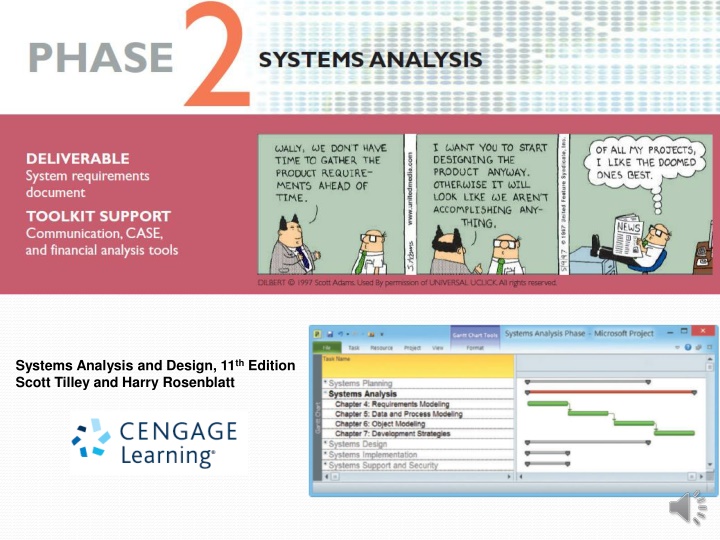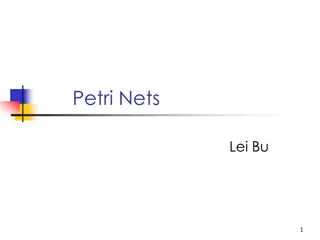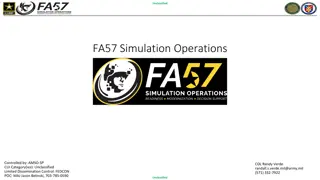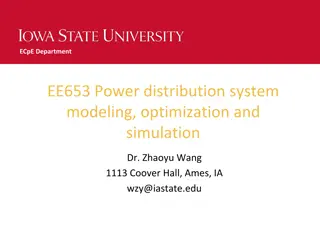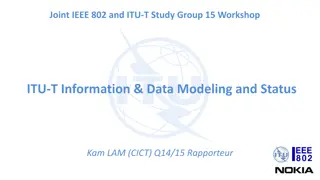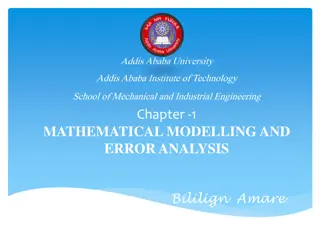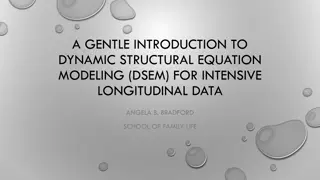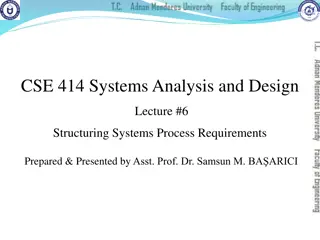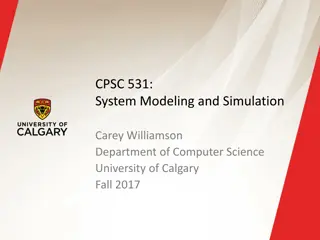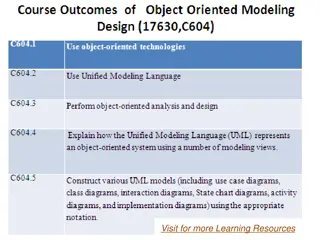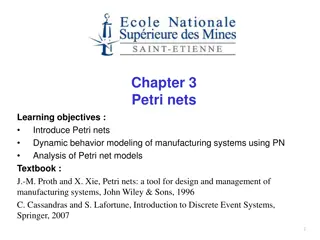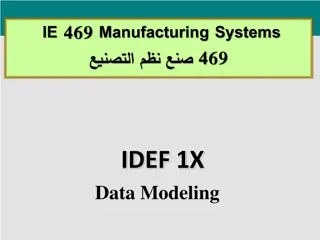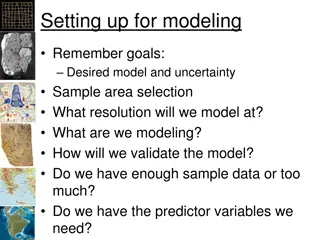Data and Process Modeling Techniques in Systems Analysis
This chapter explores data and process modeling concepts used in system analysis, including data flow diagrams, data dictionaries, and process descriptions. It covers the symbols, rules, and techniques involved in creating logical models to support business operations effectively. The chapter also discusses the use of tools like structured English and decision tables, as well as the relationship between logical and physical models.
Download Presentation

Please find below an Image/Link to download the presentation.
The content on the website is provided AS IS for your information and personal use only. It may not be sold, licensed, or shared on other websites without obtaining consent from the author.If you encounter any issues during the download, it is possible that the publisher has removed the file from their server.
You are allowed to download the files provided on this website for personal or commercial use, subject to the condition that they are used lawfully. All files are the property of their respective owners.
The content on the website is provided AS IS for your information and personal use only. It may not be sold, licensed, or shared on other websites without obtaining consent from the author.
E N D
Presentation Transcript
Systems Analysis and Design, 11th Edition Scott Tilley and Harry Rosenblatt
This chapter discusses data and process modeling techniques that analysts use to show how the system transforms data into useful information. The deliverable, or end product, of data and process modeling is a logical model that will support business operations and meet user needs. 2
Chapter Objectives Describe data and process modeling concepts and tools, including data flow diagrams, a data dictionary, and process descriptions Describe the symbols used in data flow diagrams and explain the rules for their use Draw data flow diagrams in a sequence, from general to specific Explain how to level and balance a set of data flow diagrams 3
Chapter Objectives Describe how a data dictionary is used and what it contains Use process description tools, including structured English, decision tables, and decision trees Describe the relationship between logical and physical models 4
Introduction In chapter 5, you use data and process modeling techniques to develop a logical model of the proposed system and document the system requirements Logical model shows what the system must do Physical model describes how the system will be constructed 5
Overview of Data and Process Modeling Tools Systems analysts (SA) use many graphical techniques to describe an information system A Data Flow Diagram (DFD) uses various symbols to show how the system transforms input data into useful information 6
Data Flow Diagrams A Data Flow Diagram (DFD) shows how data moves through an information system but does not show program logic or processing steps A set of DFDs provides a logical model that shows what the system does, not how it does it https://www.lucidchart.com/pages/data-flow-diagram 7
Data Flow Diagrams DFD Symbols DFDs use four basic symbols that represent processes, data flows, data stores, and entities Gane and Sarson symbol set Yourdon symbol set 8
Data Flow Diagrams DFD Symbols 1. Process symbol Receives input data and produces output that has a different content, form, or both Contain the business logic, also called business rules Referred to as a black box does not show program logic or processing steps 9
Data Flow Diagrams DFD Symbols Rules for Processes Processes cannot consume or create data Must have at least 1 input data flow (to avoid miracles) Must have at least 1 output data flow (to avoid black holes) Should have sufficient inputs to create outputs (to avoid gray holes) 10
Data Flow Diagrams DFD Symbols 2. Data flow symbol Represents one or more data items The symbol for a data flow is a line with a single or double arrowhead 11
Data Flow Diagrams DFD Symbols 2. Data flow symbol three data flow and process combinations that must be avoided: Spontaneous generation. produces output, but has no input data flow. Because it has no input, the process is called a spontaneous generation process. Black hole. which is a process that has input, but produces no output. Gray hole. A gray hole is a process that has at least one input and one output, but the input obviously is insufficient to generate the output shown Insufficient input to generate output 12
Data Flow Diagrams DFD Symbols Rules for Data Flows From external entity (source) to system From system to external entity (sink) From internal symbol to internal symbol, but always either start or end at a process 13
Data Flow Diagrams DFD Symbols 3. Data store symbol Represent data that the system stores The physical characteristics of a data store are unimportant because you are concerned only with a logical model Is a flat rectangle that is open on the right side and closed on the left side 14
Data Flow Diagrams DFD Symbols 3. Data store symbol At least has 1 incoming & outgoing data flow 15
Data Flow Diagrams DFD Symbols Rules for Data Stores Internal to the system Data at rest Include in system if the system processes transform the data Store, Add, Delete, Update Every data store on DFD should correspond to an entity on an ERD 16
Data Flow Diagrams DFD Symbols 4. Entity Symbol Name of the entity appears inside the symbol shows only external entities that provide data to the system or receive output from the system. DFD entities are also called: Terminators: data origins or final destinations. Source: entity that supplies data to the system Sink: entity that receives data from the system 17
Data Flow Diagrams DFD Symbols Rules for Entity External people, systems and data stores Reside outside the system, but interact with system Either a) receive info from system b) trigger system into motion c) provide new information to system 18
YES NO Rules for Using DFD Symbols 19
Creating a Set of DFDs Create a graphical model of the information system based on your fact- finding results Three-step process Step 1: Draw a context diagram Step 2: Draw a diagram 0 DFD Step 3: Draw the lower-level diagrams 20
Creating a Set of DFDs Guidelines for Drawing DFDs Draw the context diagram so that it fits on one page Use the name of the information system as the process name in the context diagram Use unique names within each set of symbols Do not cross lines Provide a unique name and reference number for each process Obtain as much user input and feedback as possible 21
Creating a Set of DFDs Step 1: Draw a Context Diagram A context diagram is a top-level view of an information system that shows the system s boundaries and scope. Provides the most general view of an information system and contains a single process symbol, which is like a black box. To draw a context diagram, start by placing a single process symbol in the centre of the page. The symbol represents the entire information system, and it is identified as process 0. Data stores are not shown in the context diagram because they are contained within the system and remain hidden until more detailed diagrams are created. 22
Creating a Set of DFDs Step 1: Draw a Context Diagram 23
Creating a Set of DFDs Step 2: Draw a Diagram 0 DFD To show the detail inside the black box, a DFD diagram 0 is created. Diagram 0provides an overview of all the components that interact to form the overall system. It zooms in on the system and shows major internal processes, data flows, and data stores. (Diagram 0 is an exploded view of process 0) Diagram 0 also repeats the entities and data flows that appear in the context diagram. = all the connections that flow into and out of process 0 must be retained. Parent diagram : the higher-level diagram Child diagram : the lower-level diagram Functional primitive : is a process that consists of a single function that is not exploded further. 24
Creating a Set of DFDs Step 2: Draw a Diagram 0 DFD 25
Creating a Set of DFDs Step 3: Draw the Lower-Level Diagrams Must use leveling and balancing techniques Leveling is the process of drawing a series of increasingly detailed diagrams, until all functional primitives are identified. Balancing maintains consistency among a set of DFDs by ensuring that input and output data flows align properly 26
Creating a Set of DFDs Step 3: Draw the Lower-Level Diagrams Leveling examples Uses a series of increasingly detailed DFDs to describe an information system Leveling is also called exploding, partitioning, or decomposing 27
Creating a Set of DFDs Step 3: Draw the Lower-Level Diagrams Balancing examples Ensures that the input and output data flows of the parent DFD are maintained on the child DFD For example, Figure 5-16 shows two DFDs: The order system diagram 0 is shown at the top of the figure, and the exploded diagram 3 DFD is shown at the bottom. 28
Data Dictionary A data dictionary, or data repository, is a central storehouse of information about the system s data An analyst uses the data dictionary to collect, document, and organize specific facts about the system Also defines and describes all data elements and meaningful combinations of data elements 30
Data Dictionary A data element, also called a data item or field, is the smallest piece of data that has meaning Data elements are combined into records, also called data structures A record is a meaningful combination of related data elements that is included in a data flow or retained in a data store 31
Data Dictionary Using CASE Tools for Documentation The more complex the system, the more difficult it is to maintain full and accurate documentation Modern CASE tools simplify the task A CASE repository ensures data consistency 32
Data Dictionary Documenting the Data Elements You must document every data element in the data dictionary The objective is the same: to provide clear, comprehensive information about the data and processes that make up the system 33
Data Dictionary Documenting the Data Elements The following attributes usually are recorded and described Data element name and label Alias Type and length Default value Acceptable values - Domain and validity rules 34
Data Dictionary Documenting the Data Elements The following attributes usually are recorded and described Source Security Responsible user(s) Description and comments 35
Data Dictionary Documenting the Data Flows The typical attributes are as follows Data flow name or label Description Alternate name(s) Origin Destination Record Volume and frequency 36
Data Dictionary Documenting the Data Stores Typical characteristics of a data store are Data store name or label Description Alternate name(s) Attributes Volume and frequency 37
Data Dictionary Documenting the Processes Typical characteristics of a process Process name or label Description Process number Process description 38
Data Dictionary Documenting the Entities Typical characteristics of an entity include Entity name Description Alternate name(s) Input data flows Output data flows 39
Data Dictionary Documenting the Records Typical characteristics of a record include Record or data structure name Definition or description Alternate name(s) Attributes 40
Data Dictionary Data Dictionary Reports Many valuable reports An alphabetized list of all data elements by name A report describing each data element and indicating the user or department that is responsible for data entry, updating, or deletion A report of all data flows and data stores that use a particular data element Detailed reports showing all characteristics of data elements, records, data flows, processes, or any other selected item stored in the data dictionary 41
Process Description Tools A process description documents the details of a functional primitive, which represents a specific set of processing steps and business logic It should be noted that this chapter deals with structured analysis, but the process description tools also can be used in object-oriented development, which is described in Chapter 6 42
Process Description Tools Modular Design Based on combinations of three logical structures, sometimes called control structures, which serve as building blocks for the process Sequence Selection Iteration - looping 43
Process Description Tools Structured English Must conform to the following rules Use only the three building blocks of sequence, selection, and iteration Use indentation for readability Use a limited vocabulary, including standard terms used in the data dictionary and specific words that describe the processing rules 44
Process Description Tools Structured English Might look familiar to programming students because it resembles pseudocode The primary purpose of structured English is to describe the underlying business logic 45
Process Description Tools Decision Tables Shows a logical structure, with all possible combinations of conditions and resulting actions It is important to consider every possible outcome to ensure that you have overlooked nothing The number of rules doubles each time you add a condition Can have more than two possible outcomes Often are the best way to describe a complex set of conditions 46
Process Description Tools Decision Tables 47
Process Description Tools Decision Trees Graphical representation of the conditions, actions, and rules found in a decision table Whether to use a decision table or tree often is a matter of personal preference 48
Logical Versus Physical Models While structured analysis tools are used to develop a logical model for a new information system, such tools also can be used to develop physical models of an information system A physical model shows how the system s requirements are implemented 49
Logical Versus Physical Models Sequence of Models Many systems analysts create a physical model of the current system and then develop a logical model of the current system before tackling a logical model of the new system Performing that extra step allows them to understand the current system better 50
